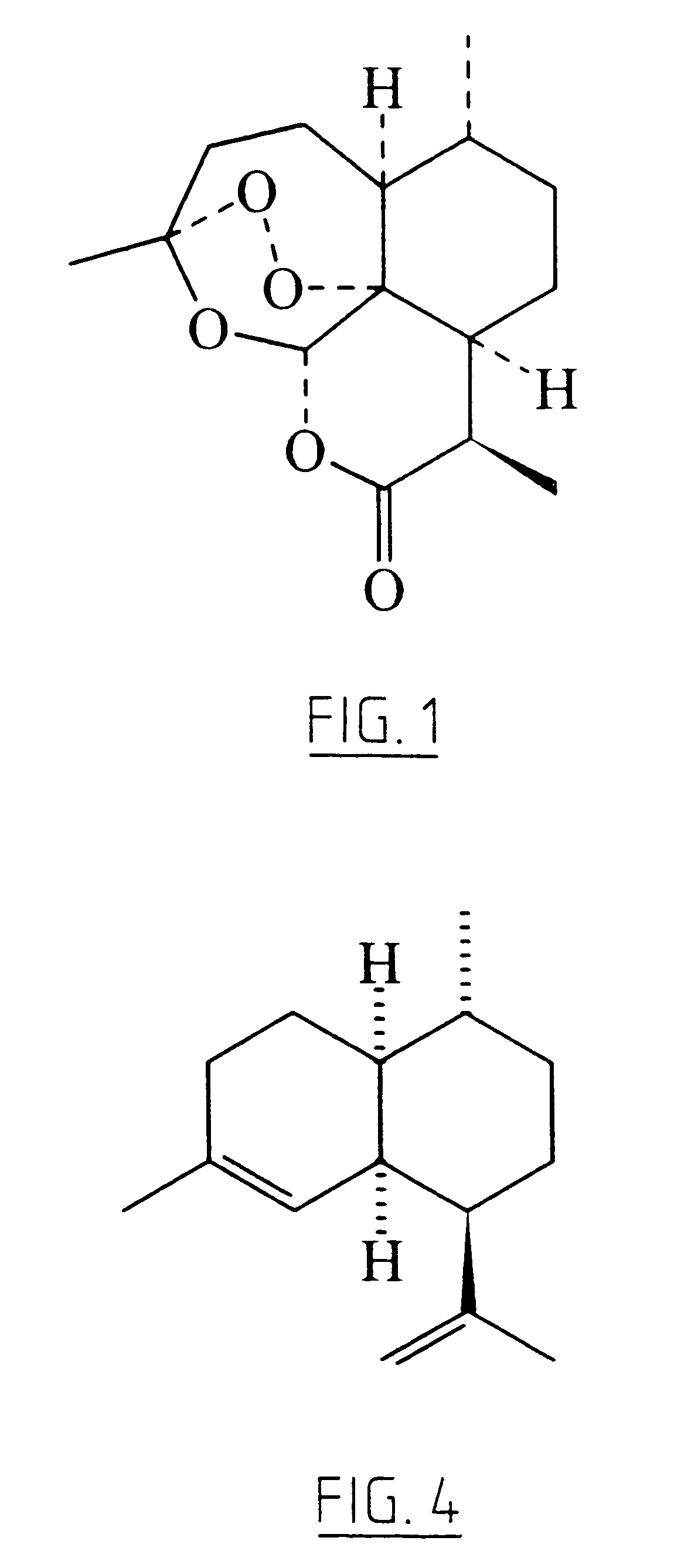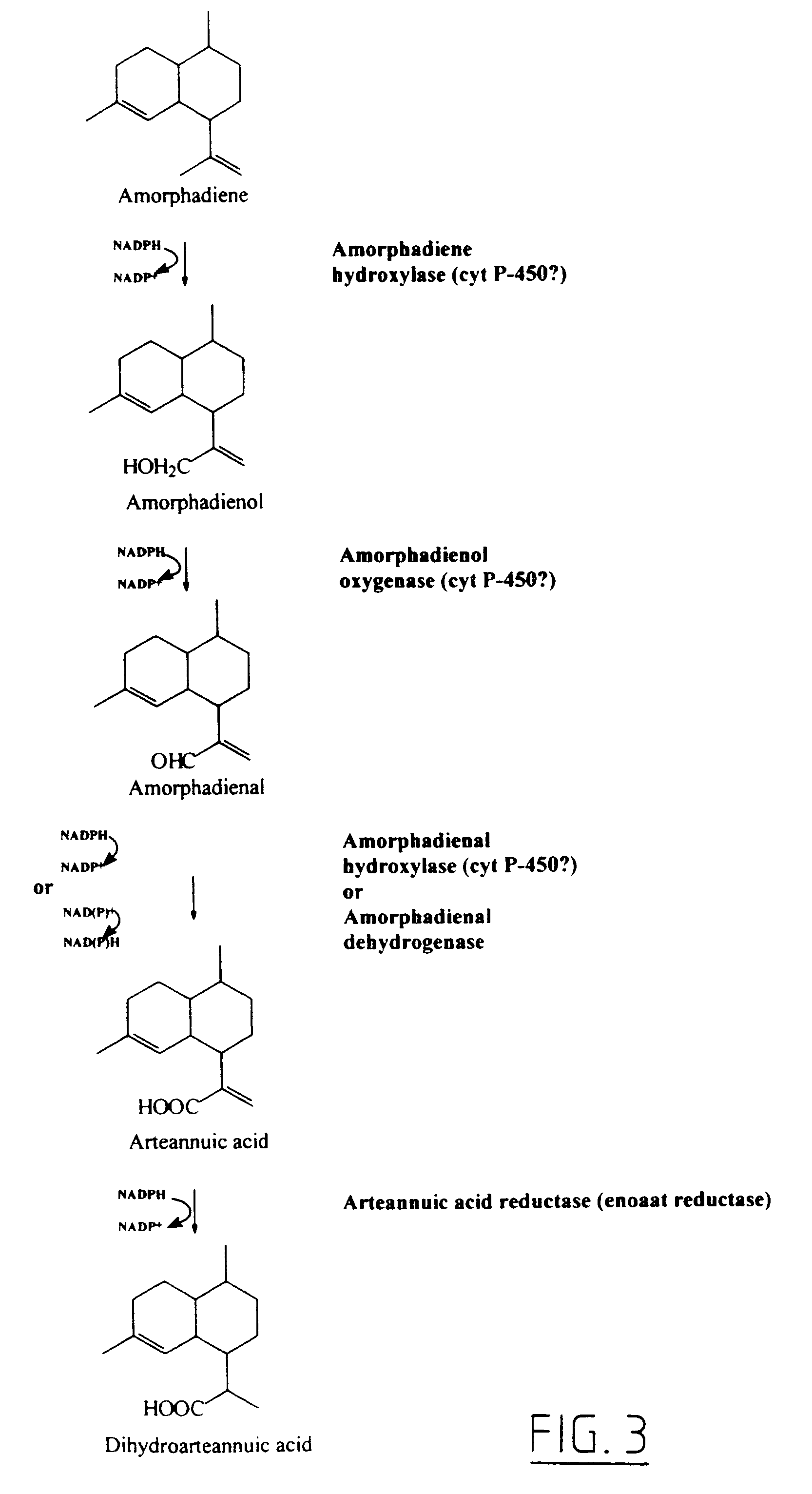Transgenic amorpha-4,11-diene synthesis
- Summary
- Abstract
- Description
- Claims
- Application Information
AI Technical Summary
Problems solved by technology
Method used
Image
Examples
example 1
Conversion of Farnesyl Pyrophosphate into Amorphadiene by Amorphadiene Synthase
A. Isolation, Partial Purification and Identification of Amorphadiene Synthase from A. annua
[0071]During enzyme isolation and preparation of the assays, all operations were carried out on ice or at 4° C. Ten grams of frozen young leaves from greenhouse-grown A. annua were ground in a pre-chilled mortar and pestle in 40 ml of pre-chilled buffer containing 25 mM MES (pH 5.5), 20% (v / v) glycerol, 25 mM sodium ascorbate, 25 mM NaHSO3, 10 mM MgCl2 and 5 mM DTT (buffer A) slurried with 1 g polyvinylpolypyrrolidone (PVPP) and a spatula tip of purified sea sand. Ten grams of polystyrene resin (Amberlite XAD-4, Serva) were added and the slurry was stirred carefully for 10 min and then filtered through cheesecloth. The filtrate was centrifuged at 20,000 g for 20 min (pellet discarded), and then at 100,000 g for 90 min. A 3-ml subsample of the supernatant was desalted to a buffer containing 15 mM MOPSO (pH 7.0), 10...
example 2
Isolation and Characterization of the Amorphadiene Synthase Encoding Gene
A. Induction of Transcription
[0076]As revealed in part III of FIG. 2, DHAA is photo-oxidatively converted into DHAA-OOH. In this reaction a reactive form of oxygen (singlet O2) is added to DHAA. DHAA plays the role of an anti-oxidant, a scavenger of reactive oxygen species. Artemisinin is the stable end product of this reaction in which reactive oxygen is stored. Under stress conditions, (for example photo-stress, frost, drought or mechanical damage) reactive species of oxygen are formed in the plant. In response to this reactive oxygen generally plants are producing anti-oxidants. It is likely that A. annua will produce DHAA as anti-oxidant in response to this release of reactive oxygen. By exposing A. annua to stress conditions the transcription of the gene encoding amorphadiene synthase will be induced. To achieve this situation A. annua plants grown under climate room conditions (23° C., 90% moisture, 3000 ...
example 3
Expression of the Amorphadiene Synthase Encoding Gene in E. coli BL21(DE3)
[0085]For functional expression the cDNA clone was subcloned in frame into the expression vector pET 11d (Stratagene). To introduce suitable restriction sites for subcloning, the gene was amplified by PCR using a sense primer (primer C) 5′-GTCGACAAACCATGGCACTTACAGAA G-3′ (SEQ ID NO: 3) (introducing a NcoI site at the start codon ATG) and an anti-sense primer (primer D): 5′-GGATGGATCCTCATATACTCATAGGATAAACG-3′ (SEQ ID NO: 4) (introducing a BamHI site directly behind the stop codon TGA). The PCR reaction was performed under standard conditions. After digestion with BamHI and NcoI, the PCR product (FIG. 12) and the expression vector pET 11d were gel purified and ligated together to yield a construct as revealed in FIG. 11.
[0086]To obtain expression, this gene construct (FIG. 11), pET 11d without an insert as negative control, and pET 11d with the tobacco 5-epi-aristolochene synthase (TEAS) gene (Back et al., Archi...
PUM
| Property | Measurement | Unit |
|---|---|---|
| Fraction | aaaaa | aaaaa |
Abstract
Description
Claims
Application Information
 Login to View More
Login to View More - R&D
- Intellectual Property
- Life Sciences
- Materials
- Tech Scout
- Unparalleled Data Quality
- Higher Quality Content
- 60% Fewer Hallucinations
Browse by: Latest US Patents, China's latest patents, Technical Efficacy Thesaurus, Application Domain, Technology Topic, Popular Technical Reports.
© 2025 PatSnap. All rights reserved.Legal|Privacy policy|Modern Slavery Act Transparency Statement|Sitemap|About US| Contact US: help@patsnap.com



